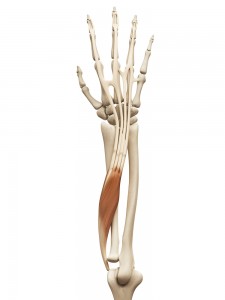Does it Hurt to Shake Hands?
Finger Extensor Muscles

Extensor Indicis
There are several finger extensor muscles. They include Digitorum, Indicis, and Digiti Minimi. If you have knots (trigger points) in any of these muscles you will feel it down the forearm into the hand and fingers and up to the elbow.
If you have trigger points in the extensor digitorum, you will have pain in the middle finger, the

Extensor Digitorum
wrist and up the forearm but most of the pain will be in the hand. You may complain of stiffness and soreness in the hands and fingers thinking you have arthritis. If you are experiencing pain and carpal tunnel symptoms, it is important to recognize these early signs to prevent permanent damage. The median nerve, which affects the thumb, index finger, and middle finger, can be impacted by pressure or inflammation in the carpal tunnel.
The pain can also mimic tennis elbow. Deep pressure causes little tenderness, but tapping causes a lot of tenderness.
The extensor indicis muscle trigger points will cause pain on the top of the wrist and hand but not in the fingers.
Other symptoms may include pain and/or weakness when shaking hands, difficulty writing, working dentistry or typing.
Causes of Wrist Pain
Back in the day women used to get trpts in the extensors by constantly holding up their long skirts. Today people get trpts in the extensors by overuse of repetitive finger movements like those of musicians, typists or mechanics. A fracture of the forearm will also most likely cause tpts in the extensors. To diagnose carpal tunnel syndrome or conditions like rheumatoid arthritis, doctors may use various tests such as nerve conduction studies and physical examinations.
To prevent carpal tunnel syndrome and manage wrist pain, it is important to take proactive measures to reduce stress on the wrists and hands.
To test for tension and trigger points in the extensors as well as stretch them, you can do the Artisan’s Finger stretch exercise. Begin with the top of the forearm facing up (hands down) and the hand and fingers open. Turn the forearm so the hands start facing towards each other and close the fingers in a smooth, continuous movement starting with the pinky and ending with the thumb wrapped around the fingers and the wrist fully flexed as if you are popeye showing off your tattoo.
To relieve pain, do not do anything that causes pain for 3-6 weeks and only gradually go back to doing what you were used to doing before the pain. Incorporating physical therapy alongside medication and home exercises can aid recovery and enhance mobility. If pain starts, back off!
When doing motions such as opening a jar or playing tennis, cock your wrist up rather than down for more support. Try shaking hands with your palm up until you feel better. (Although I think this is kind of weird…probably because I read somewhere a long time ago that when people shake hands like that the person with palm down is trying to be dominant over the other). [Another reason for hand pain]
Avoid testing painful movements until you give it at least 3 weeks. You will also want to be very careful when you sleep. Avoid sleeping with your wrist flexed. They do make some good braces that you can sleep in as well as type or whatever else you might need it for. Sleeping with your wrist flexed is a really good way to get carpal tunnel.
Try One of These Wrist Splints while you sleep to avoid flexing it. After 4-6 weeks it shouldn’t hurt to shake hands anymore!
Muscles
Bicep Pain
Ankle Pain





